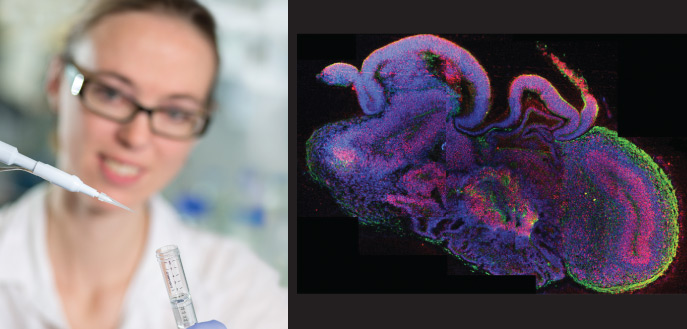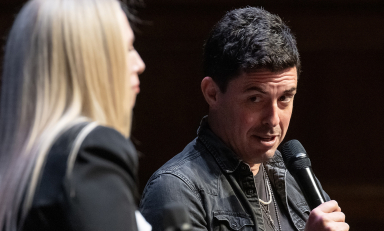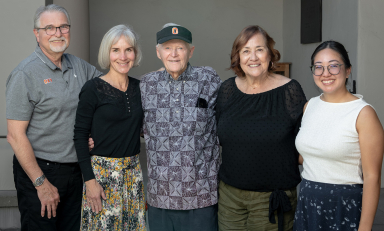
Stem-cell biologist Madeline Lancaster '04 turns genetics
on its head with a three-dimensional "organoid" that models
the human brain
By Colleen Sharkey
Lobotomies have long been banned in the United States, and Frankensteinian brain experimentation is the stuff of horror movies. But the need to study the brain, especially as it develops, remains pressing. Millions are affected by neurological diseases, and a recent study predicts that the number of Americans diagnosed with Alzheimer's disease will triple to 13.8 million by 2050. But studying the brain of a living human being has its limitations, and similar studies in rats and their rodent kinfolk aren't a sufficient proxy. So what's a scientist to do—create a brain from scratch?
In the not-so-distant past, "Making a brain-like thing in a dish would have been sci-fi, and I never thought it would have been possible," says Madeline Lancaster '04. But the Oxy biochemistry major heads up a team of stem-cell biologists at the Institute of Molecular Biotechnology of the Austrian Academy of Science (IMBA) that recently grew the first 3-D brain "organoid."
Since their findings were published last summer in Nature ("Cerebral organoids model human brain development and microcephaly"), Lancaster and her team have turned heads in the genetics community and beyond. Her organoids "would seem to have a bright future, helping scientists understand both how the brain works and what has gone wrong when it doesn't," The Economist noted. "Small though they are, they could be the start of something very big indeed."
All the attention has been gratifying for Lancaster, who did her first work in the lab with former Oxy professor Jens Frank, in cooperation with Caltech. (The Salt Lake City native opted for biochemistry over psychology, although she has a strong interest in both.) "Because Oxy is a smaller school, you get to do research even as an undergrad," says Lancaster, whose early research focused on RNA molecules ("the intermediary between DNA and the proteins that do all the work in your cells"). She did her graduate studies in biochemical sciences at UC San Diego before taking a post-doc position at IMBA, where she continues to work. Her rationale for moving to Europe was both professional and personal: She met husband Davide Gianni, an oncologist, while both were studying in San Diego, and being closer to his family in Italy was appealing for the couple.
Despite all the hoopla, Lancaster notes that organoids are not a new phenomenon. Lab-created intestines, livers, and even eyes have been used to study various diseases and to seek cures for medical conditions. In 2012, researchers at the Mario Negri Institute for Pharmacological Research in Italy created a kidney organoid that was implanted in a rat. The artificial kidney functioned successfully for several weeks, demonstrating great potential for lab-created organoids. As scientists tend to do, Lancaster and her team built upon existing work to reach their ultimate goal. "Regarding the brain," she says, "scientists have been able to do neurons in two dimensions for decades. Then one group in Japan began making individual brain regions in 3-D, and our work was influenced by that."
With no brain-making kit available off the shelf, Lancaster and her team used both embryonic stem cells that were generated in the 1990s (and were legal to use, even with strict international laws) and pluripotent stem cells to grow their organoid. The latter cells are capable of becoming any kind of cell in the body, she says. "They come from adult cells—for example, skin cells—that have their identity, but you can force them to go back to a stem cell."
One advantage of pluripotent cells, Lancaster adds, is that you can generate them from a living person. "It has a lot of hope for regenerative medicine," she says. "You could take stem cells from these people and because the cells come from the patient, there won't be any problem with rejection."
To take it a step beyond what had been done before in brain organoid research, Lancaster and her team "avoided putting too many factors—like growth factors that would force the cells to become a certain kind of cell." The only thing they do is force them toward neural identity and then try to get them to form as an embryo would.
Lancaster played around with various recipes ("like cooking!") to find the right mix of nutrients. With the proper broth and another critical ingredient—a matrix gel used in creating intestinal organoids that acts as scaffolding—the organoids develop on their own in a petri dish into the different brain regions. The final, special step is to move the organoids to a special kind of culture flask called a spinning bioreactor, which agitates the media so they get better oxygen and nutrient exchange through diffusion.
"It was particularly exciting the day that I cut one of them open to see what was growing in there," Lancaster says of her pea-sized creations. "They're just tissue, but the first time I opened it up, that was pretty amazing to see that there were developing brain regions that look like they do in a developing fetus. It was really remarkable; I wasn't expecting to recapitulate that in a dish."
Although the organoids don't form into a fully functioning brain—and Lancaster emphasizes that "we wouldn't want that for many ethical reasons"—the developing matter itself is extremely valuable for research. Organoids are particularly useful in studying neurological disorders that form as the brain is developing, such as microcephaly, which affects head circumference, and lissencephaly, or "smooth-brain" syndrome. Both disorders cause severe developmental delays and can shorten life expectancy. Organoids may allow scientists to model the folds and grooves of the brain where abnormalities or defects can indicate developmental disorders.
"We can better study brain malformations," Lancaster says. "We could potentially model autism and intellectual disabilities if they have early-development aspects." She and her team are also interested how basic brain development in humans differs from animals. They want to start closely looking at the special characteristics of human brains.
While it might appear that Lancaster hit the genetic lottery with her research—she will receive the 15,000-euro Eppendorf Award for Young European Investigators at a ceremony in Heidelberg on May 22—she attributes her breakthrough to "a combination of my specialty and entering the field at the right time."
"I worked really hard on it," adds Lancaster, who is looking for a teaching position in addition to conducting her research. "There's also an aspect of luck."
Freelance writer Colleen Sharkey lives in Budapest and insists that no monsters were created in the reporting of this story.



